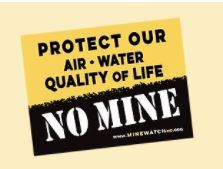Bob Crabb, our local and justifiably renowned political cartoonist, has a depiction in today’s Union (“It Takes a Village Idiot“) of the uneasy relationship between the citizens of Grass Valley and Emgold, the Canadian penny-stock speculative gold-exploration company that wants to re-open the old Idaho-Maryland Mine for — of all things! — speculative exploration .
Today’s cartoon visually suggests that this relationship may be about to get more complicated by the arrival of the US mining gorilla, Newmont Mining Corporation, which is shown in the cartoon as a gigantic hairy-armed torso towering over the city and over Emgold’s IMM project. (Newmont recently purchased the 700-acre North Star Property for the purpose, they say, of building a mine-water treatment facility).
 Crabb’s sweet image of the city of Grass Valley itself bears a strong resemblance to the helmeted goddess, Athena, patron of Athens, protector of the polis: She is shown wearing a toga and a common (non-regal) warrior’s helmet. She’s an image of purity, a portrayal of the democratic ideal in peril, looking up in wary hesitation at the fearsome hulking figure of Newmont.
Crabb’s sweet image of the city of Grass Valley itself bears a strong resemblance to the helmeted goddess, Athena, patron of Athens, protector of the polis: She is shown wearing a toga and a common (non-regal) warrior’s helmet. She’s an image of purity, a portrayal of the democratic ideal in peril, looking up in wary hesitation at the fearsome hulking figure of Newmont.
The most interesting feature in the scene is the image of IMM as a diminutive figure holding up a Canadian flag, completely wrapped like a mummy in red-tape by the city of Grass Valley, which applies the tape with one hand while holding an endless roll of it in the other.
Newmont, in Crabb’s rendering, is wielding a miner’s pickaxe, and is much too massive and powerful a creature to be restrained by red tape wielded by a mere village.
My first strong impression when I saw this cartoon was that it shouted out the message, “Poor IMM would go forward if it weren’t for all that unreasonable red tape!”
The truth, as is so often the case in politics (including political cartoons), is far different and far more nuanced.
The city, in fact, has much to fear from Emgold and its proposed IMM project. There is increasing realization among local citizens of the massive scale of the project, in striking contrast to Crabb’s miniscule image of it.
IMM’s underground mineral rights map comprises 2800 acres, an area nearly as large as the entire city of Grass Valley itself.
Look at a map of those 2800 below-surface acres and you will see that they underlie Sierra Nevada Memorial Hospital at one extent, Loma Rica at another, the airport at a third, and finally out to the confluence of Brunswick Road and the Colfax Highway.
Also massive is the use of resources it would require, if approved.
“The proposed ceramics plant would double Nevada County’s total yearly natural gas consumption. (1,100M cu. ft. per year)
“No natural gas service exists to the old mine site, and Nevada County may not have enough total pipeline capacity to supply the plant.
“The proposed mining operation yearly electric consumption is more than one third of the 2006 PG&E total supplied to all of Nevada County. (172GWhr per year)
“Diesel to fuel up to 214 20-ton truck trips per day, every day.”
(From “Energy Consumption of Proposed Emgold Mining Operations”).
These are huge impacts. Every part of Western Nevada County would be affected by that project.
The only thing about the IMM proposal that’s not huge, ironically, is the number of jobs that it would create.
Half the promised jobs would occur only if the very problematic patent-pending ceramics plant is built, and there is no way to know how many of the few remaining jobs would go to locals. But think about it: Studies of mining industry jobs show that most require both secondary education (special training) and prior experience. Does this sound like our local workforce?
Sadly, when compared to the General Plan for that site, the IMM project represents a net job loss to Nevada County, along with a huge loss in quality of life for everyone here.
Clearly, the strongest argument against approving Emgold’s IMM project application is a business argument.
If the Idaho-Maryland project application is approved, the image of Athena in that scene will need to be revised to depict a world-weary Athena dressed in a tattered and soiled robe, on her knees in abject apology to the citizens of her village, whom she has so badly served.
Read Full Post »
 Crabb’s sweet image of the city of Grass Valley itself bears a strong resemblance to the helmeted goddess, Athena, patron of Athens, protector of the
Crabb’s sweet image of the city of Grass Valley itself bears a strong resemblance to the helmeted goddess, Athena, patron of Athens, protector of the 
 Back in May, more than 26,000 Earthjustice supporters stood up to tell the Obama administration to close a massive Bush-era loophole in the Clean Water Act that is allowing mining companies to dump their toxic and dangerous mining waste directly into the waters we rely on.
Back in May, more than 26,000 Earthjustice supporters stood up to tell the Obama administration to close a massive Bush-era loophole in the Clean Water Act that is allowing mining companies to dump their toxic and dangerous mining waste directly into the waters we rely on. Emgold, the speculative Canadian penny-stock gold exploration company that hopes to re-open the old Idaho-Maryland Mine in Grass Valley, refers in
Emgold, the speculative Canadian penny-stock gold exploration company that hopes to re-open the old Idaho-Maryland Mine in Grass Valley, refers in 
